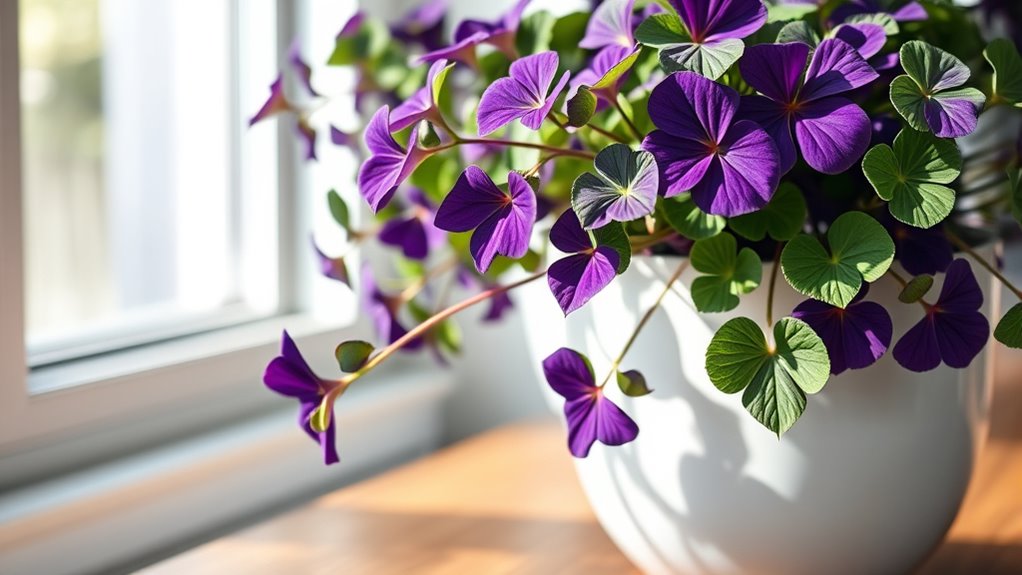To care for your indoor purple shamrock, keep its soil evenly moist but not soggy by watering when the top inch feels dry, especially during spring and summer, and less often in winter. Place it near a south or east-facing window to provide bright, indirect light, or use grow lights if needed. Avoid overwatering to prevent root rot and guarantee healthy, vibrant leaves. Staying attentive to your plant’s signals helps it thrive; learn more for ideal care.
Key Takeaways
- Water when the top inch of soil feels dry, keeping it evenly moist but not soggy.
- Provide bright, indirect light near south or east-facing windows for vibrant purple leaves.
- Use room temperature water and reduce watering frequency in winter to prevent overwatering.
- Adjust light exposure if leaves stretch or fade, and consider supplemental grow lights in winter.
- Monitor soil moisture regularly to maintain healthy growth and prevent root rot.

Have you ever wondered what compassionate, personalized care looks like? When it comes to caring for your Purple Shamrock, or Oxalis Triangularis, understanding its specific needs is essential for its health and vibrancy. One of the first steps is establishing a consistent watering schedule. This plant thrives when its soil is kept evenly moist but not soggy. You should aim to water it when the top inch of soil feels dry to the touch. During the active growing season, usually spring and summer, you may need to water more frequently—perhaps once a week—while in winter, watering can be reduced to every two weeks. Always check the soil before watering to prevent overwatering, which can lead to root rot. Using room temperature water helps avoid shocking the plant’s roots. Remember, the goal is to maintain a delicate balance: enough moisture to keep the plant healthy, but not so much that it becomes waterlogged. Proper watering practices are also crucial for maintaining optimal color accuracy in your plant’s foliage, as overwatering can dilute nutrient uptake and dull leaf coloration.
Light requirements are equally important in caring for your Purple Shamrock. This plant loves bright, indirect light. Place it near a south or east-facing window where it can receive plenty of light without direct sun, which can scorch its delicate, purple-tinged leaves. If natural light is limited, a grow light can supplement its needs, especially during shorter winter days. Adequate light encourages vibrant foliage and helps the plant maintain its characteristic tri-lobed, purple leaves. Avoid exposing it to harsh, direct sunlight for long periods, as that can cause leaf burn. Conversely, insufficient light can lead to leggy growth and dull coloration. Monitor your plant’s response to its environment; if you notice the leaves stretching or losing their rich purple hue, consider adjusting its position or increasing light exposure.
Caring for a Purple Shamrock indoors requires attentiveness to these basic needs, but it’s also about observing and responding to your plant’s cues. Maintain a consistent watering schedule that aligns with its moisture needs, and ensure it receives the right amount of light to thrive. With patience and care, your Oxalis Triangularis will reward you with its striking foliage and charming personality. It’s a plant that appreciates gentle, consistent attention, and by providing the right watering practices and light conditions, you create a nurturing environment where it can flourish. Every step you take to understand and meet its needs reflects a thoughtful, compassionate approach to plant care, making your indoor space more lively and beautiful.
Frequently Asked Questions
Can Purple Shamrock Care Be Adapted for Outdoor Environments?
Yes, you can adapt purple shamrock care for outdoor environments by ensuring the soil has good drainage and is rich in organic matter. You should also make seasonal temperature adjustments, as the plant prefers cooler temperatures in summer and warmer conditions in winter. Protect it from frost, and provide partial shade to prevent leaf scorch. With proper outdoor soil requirements and temperature management, your purple shamrock will thrive outside.
What Are Common Pests That Affect Oxalis Triangularis Indoors?
Watch out for pests like aphids, spider mites, and mealybugs that can sabotage your indoor plant health. Regularly inspect your oxalis triangularis to prevent pest problems before they start. Practice pest prevention by keeping your plant clean and isolated if you spot trouble. Staying vigilant helps you safeguard your plant’s beauty, boost its growth, and build a balanced, bug-free environment that benefits both you and your indoor oasis.
How Does Light Intensity Influence the Plant’s Color Vibrancy?
You’ll notice that light exposure directly impacts your plant’s leaf coloration and vibrancy. Bright, indirect light enhances the purple hues, making the leaves more striking. If you provide too little light, the colors fade and become dull, while excessive direct sunlight can cause scorching. To keep your Oxalis Triangularis vibrant, place it where it gets ample, filtered light daily, ensuring ideal leaf coloration and overall health.
Are There Specific Fertilizers Recommended for Continuous Growth?
Imagine giving your plant just the right whisper of nutrients to keep it lively. You should follow a balanced fertilizer schedule, applying a diluted, water-soluble fertilizer every 2-3 weeks during active growth. Focus on nutrient requirements like nitrogen, phosphorus, and potassium to support continuous growth. Avoid overfeeding, which can cause stress, and adjust feeding based on your plant’s response to make sure it stays vibrant and healthy.
How Can I Propagate Purple Shamrock Easily at Home?
You can propagate your purple shamrock easily at home through propagation methods like dividing bulbs or planting corms. The best propagation timing is in early spring when the plant begins to grow actively. Gently separate the bulbs or corms, plant them in moist soil, and keep them in bright, indirect light. With proper care and patience, you’ll soon see new growth, ensuring your purple shamrock thrives indoors.
Conclusion
Caring for your purple shamrock is like tending a delicate friendship—you nurture it with patience and attention, and in return, it rewards you with vibrant beauty. I once watched mine thrive after I adjusted its watering schedule, and it reminded me that small changes can make a big difference. Remember, your care transforms this plant from a simple houseplant into a living symbol of growth and resilience. With love and consistency, you’ll enjoy its stunning foliage for years to come.









